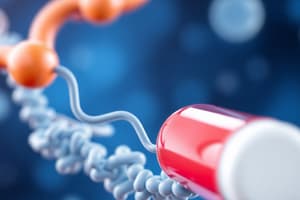Podcast
Questions and Answers
What is the primary purpose of metabolism in the body?
What is the primary purpose of metabolism in the body?
- To synthesize new drugs
- To store nutrients for future use
- To supply energy for body functions (correct)
- To eliminate waste from the body
Which organ is identified as the principal site of metabolism?
Which organ is identified as the principal site of metabolism?
- Kidney
- Heart
- Lungs
- Liver (correct)
Enzymatic transformation of drugs generally results in products that are:
Enzymatic transformation of drugs generally results in products that are:
- More toxic than the original substance
- Similar in chemical structure to the original drug
- Unable to be eliminated from the body
- Less toxic and more readily excreted (correct)
What does the term 'xenobiotics' refer to?
What does the term 'xenobiotics' refer to?
Which of the following is NOT a principal purpose of metabolism?
Which of the following is NOT a principal purpose of metabolism?
Which component carries oxygenated blood to the liver?
Which component carries oxygenated blood to the liver?
What is the role of the hepatic portal vein?
What is the role of the hepatic portal vein?
What is a key idea regarding drug metabolizing enzymes?
What is a key idea regarding drug metabolizing enzymes?
What effect does phenobarbital have on the metabolism of other drugs when given repeatedly?
What effect does phenobarbital have on the metabolism of other drugs when given repeatedly?
Which of the following is NOT classified as an enzyme inducer?
Which of the following is NOT classified as an enzyme inducer?
How do enzyme inhibitors affect drug metabolism?
How do enzyme inhibitors affect drug metabolism?
What is the primary impact of first pass effect on drug availability?
What is the primary impact of first pass effect on drug availability?
What is a significant neurotoxic effect of Phenytoin that Ms. Danvers experienced after starting Isoniazid?
What is a significant neurotoxic effect of Phenytoin that Ms. Danvers experienced after starting Isoniazid?
Which of the following best defines clearance in the context of drug elimination?
Which of the following best defines clearance in the context of drug elimination?
What pathways are primarily involved in the excretion of nonvolatile drugs?
What pathways are primarily involved in the excretion of nonvolatile drugs?
Which of the following substances is classified as an enzyme inhibitor?
Which of the following substances is classified as an enzyme inhibitor?
What role does renin play in kidney function?
What role does renin play in kidney function?
Which part of the nephron is responsible for the majority of tubular reabsorption?
Which part of the nephron is responsible for the majority of tubular reabsorption?
What is the primary function of the glomerulus in the kidney?
What is the primary function of the glomerulus in the kidney?
How does renal blood flow relate to vascular resistance?
How does renal blood flow relate to vascular resistance?
Which process in the kidney involves the removal of metabolic waste?
Which process in the kidney involves the removal of metabolic waste?
What role do sinusoids play in the metabolism of drugs and nutrients?
What role do sinusoids play in the metabolism of drugs and nutrients?
Which type of metabolite is Procaine converted into?
Which type of metabolite is Procaine converted into?
What characterizes metabolites that retain similar activity?
What characterizes metabolites that retain similar activity?
Which of the following is a reactive metabolite?
Which of the following is a reactive metabolite?
Which metabolite conversion is an example of a bioactivated metabolite?
Which metabolite conversion is an example of a bioactivated metabolite?
What is a common feature of drug metabolites compared to their parent drugs?
What is a common feature of drug metabolites compared to their parent drugs?
Which of the following statements accurately describes altered activity metabolites?
Which of the following statements accurately describes altered activity metabolites?
What is one of the three major components of drug biotransformation?
What is one of the three major components of drug biotransformation?
What is the main consequence of increased drug doses in sulfate conjugation?
What is the main consequence of increased drug doses in sulfate conjugation?
Which enzyme is primarily responsible for the methylation process in drug metabolism?
Which enzyme is primarily responsible for the methylation process in drug metabolism?
At what age is acetylation capacity considered to be developed in infants?
At what age is acetylation capacity considered to be developed in infants?
Which conjugation method is most common for aromatic heterocyclic carboxylic acid drugs?
Which conjugation method is most common for aromatic heterocyclic carboxylic acid drugs?
What characterizes enzyme induction?
What characterizes enzyme induction?
Which population characteristic affects the expression of acetyl transferase?
Which population characteristic affects the expression of acetyl transferase?
What is the primary function of glutathione conjugation in metabolism?
What is the primary function of glutathione conjugation in metabolism?
What is formed from the reaction of S-adenosylmethionine in the methylation process?
What is formed from the reaction of S-adenosylmethionine in the methylation process?
Which two conjugation processes are not fully developed at birth but are progressively matured?
Which two conjugation processes are not fully developed at birth but are progressively matured?
What is the effect of auto-induction in drug metabolism?
What is the effect of auto-induction in drug metabolism?
Flashcards are hidden until you start studying
Study Notes
Metabolism Overview
- Metabolism, also referred to as biotransformation, involves enzymatic or biochemical transformation of drugs into less toxic metabolites for easier elimination.
- Drug metabolism is a chemical process facilitated by the biological environment, aiming to supply energy, break down foreign compounds, and increase water solubility.
Liver Function and Structure
- The liver is the principal organ responsible for metabolism, acting as both a synthesizing and eliminating organ.
- Liver anatomy includes the liver lobule as the basic structural unit, hepatic artery for oxygen-rich blood, and hepatic portal vein for nutrient-rich blood.
Metabolizing Enzymes
- Drug metabolism occurs in various liver fractions, including soluble, mitochondrial, and microsomal.
- Some metabolism can also occur in the bloodstream due to enzyme leakage from cells.
Classes of Metabolites
- Inactive metabolites decrease pharmacological action (e.g., Procaine to p-aminobenzoic acid).
- Metabolites retaining similar activity continue to exert effects (e.g., Codeine to Morphine).
- Metabolites with altered activity (e.g., Iproniazid to isoniazid) may have different effects than the parent drug.
- Bioactivated metabolites are inactive until converted (e.g., Enalapril to Enalaprilat).
- Reactive metabolites can potentially be toxic (e.g., Acetaminophen to NAPQI).
Biotransformation Components
- Three major components involved in drug biotransformation are the reactant (the drug), the product (the metabolite), and the treatment provided.
Conjugation Pathways
- Sulfate Conjugation: Enzyme sulfotransferases in liver, kidney, and GI tract; limited capacity and easily saturated at high doses.
- Methylation: A minor pathway involving methyl transferase, significant for endogenous substances.
- Acetylation: Catalyzed by acetyl transferases; genetics influence speed of metabolism (slow vs. fast acetylators).
- Glutathione Conjugation: Detoxifies reactive oxygen species; critical in cellular protection.
- Amino Acid Conjugation: Glycine and Glutamine play roles in conjugation with organic acids.
Maturation of Metabolic Processes in Infants
- Metabolic capacity develops over time with significant processes emerging at various ages, such as sulfation at birth and glucuronidation around two months.
Enzyme Induction and Inhibition
- Enzyme Induction: Increased enzyme activity speeds metabolism; it is an adaptation to exogenous substances.
- Enzyme Inhibition: Results in decreased enzyme activity, leading to increased drug effects due to slower metabolism.
First Pass Effect
- Describes pre-systemic metabolism where drugs undergo transformation before systemic circulation, often reducing their bioavailability.
Excretion Mechanisms
- Excretion finalizes drug removal from the body through various routes including renal (urine), fecal, and respiratory pathways for volatile compounds.
Clearance
- Clearance reflects the rate of drug elimination from the body, measured in volume over time (mL/min or L/hr).
- The kidney plays a vital role, maintaining fluid balance and producing essential hormones like renin and erythropoietin.
Kidney Function
- Three main processes in kidney function include glomerular filtration (passive), active tubular secretion, and tubular reabsorption necessary for waste removal and electrolyte balance.
Studying That Suits You
Use AI to generate personalized quizzes and flashcards to suit your learning preferences.




